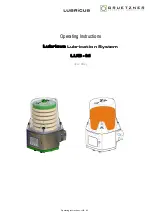
2
3
WARNING
• Failure to follow the regulations of this mounting instruction may
cause serious consequences such as risk of injury.
• Read and understand these instructions before use.
1. General description:
POWERTEX Shackles are used as removable links to connect steel
wire rope used in lifting operations and static systems, chain and
other fittings. Screw pin shackles are used mainly for non-permanent
applications. Safety bolt shackles are used for long-term or permanent
applications or where the load may slide on the pin causing rotation of
the pin.
Dee shackles are mainly used on one-leg systems whereas anchor- or
bow shackles are mainly used on multi-leg systems.
2. Marking
Powertex shackles are generally marked with:
- Working Load Limit e.g. WLL 25t.
- Steel grade e.g. 6.
- Manufacturer’s symbol e.g. Powertex, PTEX or PX.
- Traceability code e.g. F3 (indicating a particular batch).
- CE conformity code
.
Additional Powertex shackles are marked with the
following:
- size in inches e.g. 1 3/4.
- arrows to indicate 45 degree angle.
- according to EN 13889: EN (from 2t and up).
raised pad (on the back) for individual stamping
Powertex shackles meet all relevant requirements of the Machinery
Directive 2006/42/EC and its latest amendments.
3. Finish
Powertex Shackles are hot dipped galvanized.
4. Certification
Powertex shackles are in compliance with:
EN 13889
US Federal Specification RR-C-271
Although EN 13889 only cover the range of Working Load Limits 0,5 t to
25 t maximum, the Powertex shackles are all manufactured according
to EN 13889.
5. Testing
Powertex shackles are proofload tested at WLL x 2.
6. Instruction for use
Select the correct type and WLL of shackle and WLL for the particular
application. If extreme circumstances or shock loading may occur, this
must be well taken into account when selecting the correct shackle.
Please note that commercial shackles are not to be used for lifting
applications.
7. Assembly
Shackles should be inspected before use to ensure that (if criterias are
not in place, the shackle must be rejected):
a) the body and the pin of the shackle are both identificable as being of
the same size, type and mark;
b) all markings are readable;
c) the threads of the pin and the body are undamaged;
d) the body and pin are not distorted;
e) the body and pin are not unduly worn;
f) the body and pin are free from nicks, gouges, cracks and corrosion.
g) never use a safety bolt type shackle without using a secure pin.
h) shackles may not be heat treated as this may affect their WLL.
i) never modify, repair or reshape a shackle.
Ensure, where appropriate, that the pin is correctly screwed into the
shackles eye, i.e. tighten finger tight, then lock using a small tommy bar
or suitable tool so that the collar of the pin is seated on the shackle eye.
Fig. A.2
Ensure that the pin is of the correct length so that it penetrates the full
depth of the screwed eye and allows the collar of the pin to bed on the
surface of the drilled eye.
In all cases, when the pin is correctly fitted in the body of the shackle,
the jaw width A should not be significantly reduced.
Incorrect seating of the pin may be due to a bent pin, the thread fitting
too tightly or misalignment of pin holes. Do not use the shackle under
these circumstances.
Never replace a shackle pin except with one of the same size type and
mark as it may not be suitable for the loads imposed.
8. Usage
Select the correct type of shackle for a particular application from the
information given in the below mentioned situations:
Shackles should not be used in a manner that imposes a side loading
unless specifically permitted by the manufacturer. In general this means
that the shackle body should take the load along the axis of its centreli-
ne. (See figure A.1).
Fig. A.1
When using shackles in conjunction with multi-leg slings, due consi-
deration should be given to the effect of the angle between the legs of
the sling. As the angle increases so does the load in the sling leg and
consequently in any shackle attached to the leg.
When a shackle is used to connect two slings to the hook of a lifting ma-
chine, it should be a bow type shackle assembled with the slings in the
shackle body and the hook engaged with the shackle pin. The included
angle between the slings should not exceed 120°.
To avoid eccentric loading of the shackle
a loose spacer may be used on either
end of the shackle pin (see figure A.2).
Do not reduce the width between the
shackle jaws by welding washer or
spacers to the inside faces of the eyes
or by closing the jaws, as this will have
an adverse effect on the properties of
the shackle.
When a shackle is used to secure the top block of a set of rope blocks
the load on this shackle is increased by the value of the hoisting effect.
Avoid applications where due to movement (e.g. of the load or the rope)
the shackle pin can roll and possibly unscrew. (See figures A.3 and A.4).
Summary of Contents for PBSB
Page 8: ...8 ...
Page 10: ...www powertex products com ...




























